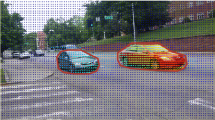Abstract
In this paper, a new method is presented for 3D motion estimation by image region correspondences using stereo cameras. Under the weak perspectivity assumption, we first employ the moment tensor theory (Cyganski and Orr[11]) to compute the monocular affine transformations relating images taken by the same camera at different time instants and the binocular affine transformations relating images taken by different cameras at the same time instant. We then show that 3D motion can be recovered from these 2D transformations. A space time fusion strategy is proposed to aim at robust results. No knowledge of point correspondences is required in the above processes and the computations involved are linear. To find corresponding image regions, new affine invariants, which show stronger invariance, are derived in term of tensor contraction theory. Experiments on real motion images are conducted to verify the proposed method.
Similar content being viewed by others
References
H.C. Longuet-Higgins, A computer algorithm for reconstructing a scene from two projections.Nature 239, 1981, 133–135.
R.Y. Tsai and T.S. Huang, Uniqueness and estimation of three-dimensional motion parameters of rigid objects with curved sufaces.IEEE Trans. on Pattern Analysis and Machine Intelligence, 1984, 6(1), 13–27.
Y. Liu and T.S. Huang. Estimation of rigid body motion using straight line correspondence: Further results. Proc. Int. Conf. on Pattern Recognition, Paries, France, Oct. 27–31, 1986, 306–309.
Y. Liu and T.S. Huang, A linear algorithm for motion estimation using straight line correspondences.Computer Vision, Graphics, and Image Processing, 1988, 44(1), 35–57.
S-I Amari, Feature spaces which admit and detect invariant signal transformations. Proc. Int. Conf. Pattern Recognition, Kyoto, Japan, Nov., 1978, 452–456.
Y. Aloimonos and A. Basu, Shape and 3-D motion from contour without point to point correspondence: General principle. Proc. IEEE Int. Conf. Computer vision and Pattern Recognition, Miami, Florida, June 22–26, 1986, 519–527.
C. M. Brownet al., Texture, contour, shape and motion.Pattern Recognition Letter, 1987, 5, 151–168.
Y. Aloimonos and J.Y. Herve, Correspondenceless stereo and motion: planar surfaces.IEEE Trans. Pattern Analysis and Machine Intelligence, 1990, 12(5), 504–510.
K.-I. Kanatani, Tracing planar surface motion from a projection without knowing the correspondence.Computer Vision, Graphics, and Image Processing, 1985, 29(1), 1–12.
K.-I. Kanatani, Detecting the motion of a planar surface by line and surface integrals.Computer Vision, Graphics, and Image Processing, 1985, 29(1), 13–22.
D. Cyganski and J.A. Orr, Applications of tensor theory to object recognition and orientation deterimination.IEEE Trans. Pattern Analysis and Machine Intelligence, 1985, 7(6), 662–673.
M.K. Hu, Visual pattern recognition by moment invariants.IRE Trans. on Inf. Theory, 1962, 8(2), 179–187.
D. Lovelock and H. Rund, Tensors, Differential Forms, and Variational Principles. New York: Wiley Interscience, 1975.
D.W. Thompson and J.L. Mundy, Three dimensional model matching from an unconstrained view point, Proc. IEEE Int. Conf. Robotics and Automation, Raleigh, NC, Mar., 1987, 298–320.
B.C. Vemuri and G. Skofteland, Motion estimation from multi-sensor data for telerobotics. Proc. IEEE Workshop on Intelligent Motion Control, Istanbul, Aug. 20–22, 1990.
K. Krice, Multi-frame feature based motion estimation analysis. Proc. Int. Conf. Pattern Recognition, Atlantic City, N.J., June 16–21, 1990, 114–118.
J. Weng, T.S. Huang and N. Ahuja, Error analysis of motion parameters estimation from image sequence. Proc. Int. Conf. on Computer Vision, London, England, June 8–10, 1987, 703–707.
K. Arbter, W.E. Synder, H. Hurkhardt and G. Hirzinger, Application of affine-invariant Fourier descriptors to recognition of 3D objects.IEEE Trans. Pattern Analysis and Machine Intelligence, 1990, 12(7), 640–647.
S.D. Ma, G.-Q. Wei and J. Huang, Segment based camera calibration.Journal of Computer Science and Technology, 1993, 8(1), 11–16.
J. Shen and S. Castan, An optimal linear filter in edge detection. Proc. of the IEEE Conf. on Computer Vision and Pattern Recognition, Miami, Florida, June 22–26, 1986, 104–109.
G.-Q. Wei, Z. He and S.D. Ma, Fast moment calculation: Discrete form, analytic form and parallel implementation. Proc. Int. Conf. Computer Aided Technology, Hong Kong, 1988.
A. Mitiche, On combining stereopsis and kineopsis for space perception. Proc. 1st Artificial Intell. Appli., Denver, CO, Dec. 5–7, 1984, 156–160.
A.M. Waxman and J.H. Duncan, Binocular image flows: steps toward stereo motion fusion.IEEE Trans. Pattern Analysis and Machine Intelligence, 1986, 8(6), 715–729.
A.M. Waxman and S.S. Sinha, Dynamic stereo: passive ranging to moving objects from relative image flows.IEEE Trans. Pattern Analysis and Machine Intelligence, 1986, 8(4), 406–412.
K.M. Mutch, Determining object translation information using stereoscopic motion.IEEE Trans. Pattern Analysis and Machine Intelligence, 1986, 8(6), 750–755.
Author information
Authors and Affiliations
Rights and permissions
About this article
Cite this article
Wei, G., Ma, S. 3D Motion estimation and motion fusion by affine region matching. J. of Comput. Sci. & Technol. 8, 17–25 (1993). https://doi.org/10.1007/BF02946582
Received:
Revised:
Issue Date:
DOI: https://doi.org/10.1007/BF02946582




